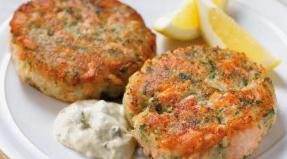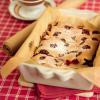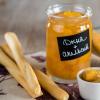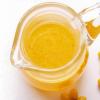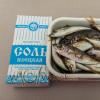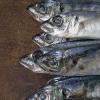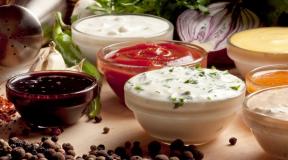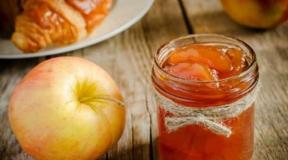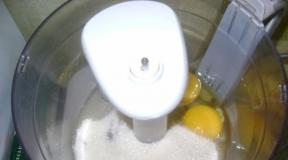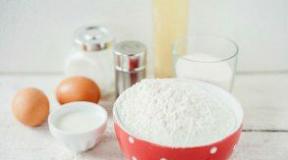How to color white beans with food coloring. How to color rice with food colors
For children's games and the development of fine motor skills of hands, cereals, small stones, buttons, pasta, beans and peas are used. Elements painted in different bright colors look beautiful. In the article, we will tell you how to properly paint rice with dyes so that the rice is colored, and the child will be more interested in playing with them. This is quite simple to do, there are even several options for how it can be done.
You can make several separate jars, each of which contains cereals of the same color. Such material can subsequently be used to make crafts with your own hands, for example, paintings from natural materials. You can mix different colors by combining the cereal for the sensor box. How to color rice in different ways, read on in the article.
What is the best way to dye cereals?
There are quite a lot of coloring methods, but some dyes work for a short time, over time the rice fade, the colors fade and acquire a grayish tint. This happens if you paint rice for children with gouache paints or watercolors. In addition, during the game, hands may remain stained and things may get dirty. However, if you make a craft out of cereals on the table surface, then this method can be safely used. It is easy to paint, and after working with the material, it will be enough to wash your hands. In order for the craft to retain its bright colors, the picture after production is opened with acrylic varnish.
How to color the rice so that it is smooth, evenly colored, and the colors last for a long time without getting your hands dirty? A high-quality color is obtained if you use ordinary food colors. Many have already used them when dyeing Easter eggs. This method can be used to prepare a sensor box, where small multi-colored elements are mixed in a chaotic manner. The brightness of such colors remains for a long period, although the child often touches the rice mass.
There are mothers who fundamentally do not want their children's hands to touch chemical dyes, therefore, before dyeing rice, they prepare natural dyes. In the article, we will explain in detail all the methods of dyeing, what additional materials are needed, how to dry rice and where it is better to store dyed cereals.
Necessary materials
- The first step is to buy rice. Some people like to work only with an elongated one, but, in principle, you can buy absolutely any. There is no need to boil rice, we will work with raw cereals.
- Before dyeing rice with food colors, prepare empty containers for each color separately. These can be plastic cups for yogurt or sour cream, mayonnaise glass jars, etc.
- A metal spoon (it is easier to wash it after the dye than a wooden one).

- Paint, depending on your wishes and preferences. These can be kits with food dyes, fresh gouache paints, watercolors in tubes, acrylic paints, or independently obtained from natural materials.
- Foil or polyethylene sheets. They are used to dry cereals in the oven or naturally on the windowsill.
- Before dyeing rice with gouache, purchase zip bags. It is convenient to use them to distribute the paint over the entire rump with your fingers.
- Strengthener.
Additional ingredient
It is not recommended to dilute the above-mentioned water in water, because the cereals will become sour from it, and the rice will dry for a very long time, or it may even deteriorate over time. How to color rice with food colors for a child? To stir in a jar, add vinegar or ethyl alcohol to the powder (some people use vodka or an antibacterial hand gel, which can be replaced with glycerin).
From vinegar, the paint lays down evenly and does not crumble later, and from glycerin or gel, the painted grain will shine beautifully.
Step-by-step instructions for working with food colors
Food colors of different colors are sold in kits at any supermarket. They are not expensive, so the work will not be too expensive.
Step 1. Pour the powder from the bag into separate containers and fill it with alcohol. The more liquid in the jar, the paler the color will turn out. This way you can get delicate or more saturated shades.

Step 2. Pour rice into the stirred solution with a metal spoon and stir for several minutes until the rice acquires the tone we need.
Step 3. Then take out the rice with the same spoon and spread it on the prepared bedding. If you are going to dry the material in the oven, then use foil or parchment paper for baking. For each color, you need to prepare a separate rectangle. If you dry rice on the windowsill in a natural way, then you can take a plastic bag or old rags.
Drying times are different depending on the ambient temperature and the season. It is best to paint the rice in the evening, and the next day to start playing or making crafts.
Use of ready-made paints
Next, let's look at how to paint rice using gouache, acrylic paints or watercolors in tubes as dyes. Prepare a plastic bag for each color. It is most convenient to use those that have side fasteners, but a more spacious option is also suitable, only it will have to be tied with a strong knot.

Spoon the rice into each bag. Then they take a tablespoon of paint and put it on top of the cereal. For 1 glass of rice, on average, you need 1 tbsp. l. paints. Then the bag is fastened or tied and shaken thoroughly. In this case, you can lightly rub your fingers through the bag of rice so that the paint covers all the elements from different sides. Then the rice is laid out to dry in the usual way.
How to color rice with natural dyes?
If you don't have purchased paints at hand, you can use the gifts of nature and make them yourself. Let's consider some of the most popular colors for crafts and from what such paints can be created.

- The green color of rice is obtained by pouring a little greenery into the bag. Another option is greens such as spinach. In a container, you need to pour boiling water over it and, after cooling, strain through a sieve.
- Orange - from finely grated carrots or tangerine zest.
- Yellow - is obtained by stirring turmeric powder with alcohol.
- Red - can be made from any juice of matching berries - strawberries, red currants, cranberries, etc.
- The burgundy color is created from cherry juice.
- Pink will help make beets.
- Purple or lilac is obtained from black currant.
- The brown tint is made from natural coffee or cocoa powder.
Since the juices have a high water content, after dropping into the container, the rice is kept for a short time so that it does not swell too much. Then the cereals are removed from the jar and spread to dry on a flat surface in a thin layer. This will dry the cereal faster.
Kitchen interior decoration
A craft with multi-colored rice, laid out in layers, looks beautiful in the kitchen. To do this, you can use not only a beautifully shaped jar, but also an original bottle.

Rice is poured on a metal or wooden stick placed in a container in layers, alternating colors. The craft turns out to be bright and serves as a real decoration of the kitchen shelf.
Children's games with sensory boxes
Recently, all parents and teachers have understood the benefits of playing with small objects for children. Tactile and sensory perception of the surrounding reality develops. Children learn not only colors, but also work with their fingers, learning objects. Colorful rice is often used for the sensor box. The colors in the container are mixed, resulting in a variegated coating several centimeters deep. As a game, the child can be offered a treasure hunt, that is, collect the coins scattered in the rump.

You can play with plastic cups by pouring rice from one jar to another, measuring how many small caps fit in a large bowl. It is interesting to "plant vegetables" or just dig a small spatula into the groove.
Older children can be offered to dig an underground passage or arrange a road on which there will be holes and rubble that will need to be dismantled. You can arrange a whole park of homemade trees. Imagine with the children, they will find a use for the box. If there is a magnet, then coins can be collected using it.
Material for crafts
You already know how to paint rice, let's see how you can make a beautiful picture with it. For ease of use, dried rice is poured into different bowls. On the surface of cardboard or fiberboard, a drawing of the future image is applied with a simple pencil.

Then the surface is partially smeared with PVA glue, and the rice is laid out in the desired color. Until the glue seizes, you need to correct the direction of the cereal with a toothpick or wooden skewer. The work will look beautiful not only with the correct placement of flowers, but also when the rice is laid in even rows. This work is painstaking and time-consuming, but the craft is spectacular. In order for the work to be preserved, and the material does not fall to the floor over time, the painting must be covered with a layer of acrylic varnish.
As you can see, there are many ways to color rice, but they are all pretty simple and cheap. You can play with multi-colored cereals and make various crafts from rice, both for children and experienced handmade craftsmen.
Rice can be used to make sushi, puddings, and other dishes. Dyeing cereals in various shades allows you to create original and aesthetic compositions. Colored grains of rice are also used for other purposes: to play and develop tactile sensitivity in children, as well as improve fine motor skills. Synthetic pigments are a safe, quick and convenient way to obtain the desired shades of cereals.
Which dye to choose
There are natural colors that can be used to give the rice different shades. This juice of beetroot, spinach, turmeric, saffron, but the choice of natural colors is limited. Naturally dyed rice acquires only a slight sheen, and it is very difficult to brighten up the color.
Synthetic dyes allow you to get almost any shade - from bright blue to emerald. In the Tortlandia online store you can buy food colors: dry, liquid, gel-like. They are safe and easy to use.
Cooking rice coloring
In cooking, it is recommended to pre-boil the rice in accordance with the instructions on the package. Cooking time depends on the type of cereal and the recipe. For example, for sushi and puddings, round grain rice is used, which needs to be cooked for 15-20 minutes.
- The dry dye is diluted in a small amount of water (from 1 teaspoon to 1 tablespoon, depending on the volume of the cereal) and mixed with rice.
- Liquid and gel dyes are completely ready-to-use. Usually, no more than 1 g of paint is required per 1 kg of boiled rice. The additive is mixed with the cereal and evenly distributed over it.
After staining, you need to wait at least 10-15 minutes for the pigment to be absorbed into the grains. This will avoid discoloration of other ingredients in the dish.
Coloring rice for children's creativity
If you need to get multi-colored grains for educational games, it is recommended to take long-grain rice. Coloring can be carried out using various methods:
- Mix dry rice with a small amount of dye (no more than ½ teaspoon per 1 kg of cereal). Dissolve the dry dye in a few drops of water. It is not recommended to take a lot of liquid: this can lead to swelling of the cereal. It is not required to dilute liquid and gel formulations with water. After thorough mixing, the cereal should be poured onto a sheet of paper or a diaper and allowed to dry for several hours. During this time, the dye will be absorbed and will not get your hands dirty when playing.
- If time is limited, you can use the express method: the rice is thoroughly mixed with the dye, and then placed in the oven for 40 minutes (temperature - 190 °). After cooling, the cereal can be immediately used for developmental activities.
For many games described in the book "Iceberg on the Carpet", the playing field is a sensory box - a container with any filling that your imagination only allows. It enables the child to expand his tactile experience - he can touch, pour, pour, explore, bury, dig up and just play, and all this does not require large material costs. Here's how to make this useful in-game item.
The basis can be:
- wash basin
- a large plastic container in which all sorts of unnecessary things are usually stored in closets
- cardboard box
- large saucepan or bowl
- jam bowl
- wooden box
- small inflatable pool
It is convenient if the sensor box has its own cover. Then you can easily close it after the game, push it, for example, under the bed and be sure that dust does not accumulate there and nothing crumbles.

The main component of the sensor box is the tactile material.
How to fill the box:
- various cereals: rice (white and colored with food colors), semolina, oatmeal
- flour, cocoa, ground coffee, starch
- coarse salt, all kinds of pasta
- beans, peas
- in winter: snow or sand, it's so great when you can play in the sandbox not only in summer, but also at home in winter
- pebbles
- aqua soil
- natural materials: acorns, chestnuts, cones, grass, leaves, rose hips, earth, stones, shells, moss
- cut paper, cotton balls, paper balls, paper napkins
What "tools" can be used in sensor boxes:
- scapula, spoons, scoops, ladle, slotted spoon
- plastic cups, buckets, egg packaging
- muffin pan, ice cream spoon, salad spoon, funnel, sieve, small silicone molds, ice mold, cookie cutters
- forceps, tweezers
- toy rake, watering can, children's garden gloves
- toys: small figures, animals, cars, toy food, dishes.
The main thing is not to give the child everything at once, because it is very easy to get confused by the abundance of details in the game.

Sensory box with colored rice
You will need:
- alcohol (vodka or hand sanitizer)
- food colorings
- small bags that can be tied
- foil or baking paper
- yogurt glass
- sensor boxes
- Dilute the dye with alcohol. You can do this in yogurt cups so you don't accidentally paint the dishes you want. For a light shade, take 4-6 drops of the dye and mix them with three tablespoons of rubbing alcohol. Another option is to mix the dye with a small amount of hand sanitizer.
- Pour half a kilo of rice into a bag, pour in the diluted dye.
- Tie the bag and wrinkle and sort the tied bag of rice for about a minute, and you will see how gradually all the rice will turn into the color of your choice.
- Open the bag and pour and flatten the wet rice on a pre-cooked sheet of foil or baking paper.
- Now it remains to wait half an hour until the rice dries, and then pour it into a dry bag. Let the game wait. Don't worry, there will be no alcohol odor.
- When all the rice is colored, you can pour it into the box intended for the game and start playing. Children need nothing more than paddles and small bowls for their first exposure to sensory play. It is very pleasant to just sort the rice with your hands.
What to play with rice
Kitchen. Give your child different kitchen utensils: a funnel, an ice cream spoon or measuring spoon, a whisk, a muffin tin, and let him prepare delicious "dishes" for himself and for you.
Treasures. While the child does not see, bury something small there: a small toy, a glass ball - this is for older children, or, for example, a tangerine, and invite the child to look for the treasure. You can search for letters and even whole words.
Garden. Let your sensory box turn into a garden bed. Together with your child, come up with what you will grow, and you can start planting. If you have plastic flowers at home, they will be very useful to you, because they are so easy to bury and seem to be "watered" from a toy watering can.
You can arrange a game in the garden using a cardboard egg box.

You will need:
- empty egg box
- cardboard
- scissors
- paints (such as gouache) and a brush
- chenille wire
- a few buttons or beans
- Cut the egg carton into small cells.
- Paint them in different colors, such as lilac for eggplant, burgundy for beets, and orange for carrots.
- When the "vegetables" are dry, make a hole in the upper part (I made it with ordinary scissors) and insert the chenille wire there. You will have great tops.
- Make some vegetable plates out of cardboard. Stick them into the ground.
- Give the child small buttons or beans to be seeds, and have the child plant the seeds in a row behind each tablet and water them from the toy watering can.
- After a while, the vegetables will start to "grow" - plant ready-made cardboard vegetables.
- And then give the child a basket and let him reap the harvest. You can also plant cardboard mushrooms in the sensor box, and then collect them in the basket.

Construction. Just a few small cars, cubes - and you can start building houses. And from the twigs you can build a hut.
Railway. If you have a large enough box, then you can build a small circle of the railway there. And then on the way, the trains will grow rice heaps, and you will have to dig out the rails so that the trains can hit the road again.
Magnetic searches. If you have a large magnet, play a metal detector. We assembled our "apparatus" from a constructor and attached a magnet with a handle to it. I hid various coins in a box with rice, and we played who would collect all the coins with a magnet faster. And then they considered who made the most money.
Do not immediately leave your child alone with the game, even if it seems to you that you have already made a lot of efforts in order to create a decent play situation. Just show him what and how to play, discuss different tactile sensations, because often so little is needed to really interest the child. And then be sure to give him time to play independently.
"What about cleaning?" - you ask. When my son Osya was little, I cleaned myself after the game. Now that Osya has matured, we bought him a baby brush, and if something wakes up outside of the box, Osya helps me clean up when she finishes playing. And we also close the box with a lid right after the game so that nothing accidentally wakes up.
Discussion
The development of fine motor skills is very important for the development of a child's speech and thinking, and with such games, development will be active and cognitive. I will definitely use these ideas.
Comment on the article "Rice, Box and Fantasy: 6 Ideas for Educational Games"
More on the topic "Rice, box and fantasy: 6 ideas for educational games":
Recently, the request in search engines - "Educational games for children" has become very common. Parents began to think more often, practically from birth, about what their child plays with, what games, how it helps his development and affects his psycho-emotional state. Indeed, from the very birth, the child begins to learn about the world, and this happens best of all in the game. It is in a playful way that the mother tries to communicate with the child, showing body parts, dressing the child, doing ...
We continue to get to know each other: the fourth summer shift (06-19 July 2017) is dedicated to the Release of Fire The destructive power of the unbridled elements of fire and the ability to warm a cold heart with the flame of a small candle. Glitter in the eyes and fire in the soul. The flame of passion and the power of the mind Our mind has endless possibilities, and the cells of our brain are able to remember and process phenomenal amounts of information. So who are we - super-powerful computers that dominate the world or are just puppets in the game ...
A handmade gift is unusual and fun! A gift shaving set or cologne cannot evoke as much joy and delight as a personal unique gift that is not sold anywhere. This is an opportunity to surprise your loved one and show him that you have a good sense of humor - they appreciate it in girls. Today I have collected 6 unusual ideas for those who decided to congratulate the guy in a special way. See also: what to give a guy for his birthday Idea # 1: A gift for ...
I present to you the Ford Boyard program in a modern way. In the world of innovations, the rapid pace of development could not pass by the innovations in the choice of the designation of actions - this is # (hashtag). We will follow exactly these notation. As everyone remembers the essence of the game Ford Boyard is the passage of stages to the final goal. So in this modification, you need to go through certain # bases, on which, for completing tasks, the team will receive # forumwaternsecond in the final # seventh base. Let's start with ...
1. "Pick up the lid" Children love to play with objects used by adults, do not deprive them of their pleasure. Take different containers and lids from your kitchen. Invite your baby to pick up, or maybe close with a lid, each bottle or jar. Undoubtedly, you will have to prompt and help the kid, but one thing is that he will try to complete the task on his own very well. 2. "Who is speaking?" Let the phone ring (toy or even a real one), remove the pipe and ...
Development of logic. 1. "Collect only" (learn to choose from the scattered objects only certain ones - according to the instructions of the mother. For example - put only cones in a box, only red objects, etc.). 2. Learn to sort objects (by shape, size, color). 3. Collect the simplest puzzles or pictures cut into pieces (in one and a half years these will be two-piece puzzles, the average child usually learns to add more complex shapes on his own after two years). 4. Assemble from parts - games from ...
Onigiri (rice balls) (お に ぎ り (御 握 り)) is a Japanese dish made with unleavened rice, which is then shaped into a triangular shape. As a rule, you can put any filling in onigiri and then wrap it in a nori sheet. Or mix the filling with the rice, and wrap it not in nori, but in a lettuce, Japanese omelette or bacon. In Japan, onigiri are insanely popular. Onigiri - from lat. "compress". It's not difficult to cook them - we take rice, make a depression in the middle ...
Spring is the time to spend holidays in nature, including for children. If you have a similar event ahead of you, take with you a pre-prepared magic chest. He will not let any of the little guests get bored. We will put small, but very entertaining things in the chest. # 1. Disposable cardboard cups. Conduct a competition with the guests - who will build a pyramid from inverted cups faster. Bottom row - 5 pieces, then 4, etc. If the children are older, then for ...
For full development, children need educational games from birth. Cards for kids play an important role in the development of your baby. This is the easiest way for a child to get acquainted with the objects depicted on the cards, as well as with the letters. View on Yandex.Photos Games with educational cards for children from 1.6 years and older If you have already studied using educational cards for children before, then, for sure, your child already knows all animals, professions, musical instruments and others ...
Creative hour "Door to Fantasy" March 30, 11:30 and 12:30 Bookstore "DodoFilion" at Bagrationovskiy proezd, 5 (SEC "Filion", 1st floor) At the creative studio "Door to Fantasy" we will read every time a new good book or excerpts from it - and draw (glue, cut, sculpt from the most unexpected materials) illustrations for it, play various games, depict scenes. Let's get to know the Kingdom of Fantasy through our own creativity! Along the way, we will - learn new things about the form ...
Bookstore "DodoFilion", Bagrationovskiy proezd, 5 (SEC "Filion", 1st floor) DodoFilion brings together very brave children, as well as art lovers and beetles! for the Creative hour "Door to Fantasy" on March 15, 11:30 and 12:30 At the creative studio "Door to Fantasy" we will read each time a new good book or excerpts from it - and draw (glue, cut, sculpt from the most unexpected materials) to her illustrations, play a variety of games, depict scenes. Let's get to know the Kingdom of Fantasy through ...
This is what all children dream about, but for some reason parents do not always guess about it. It is very easy to give a child a basin of happiness! Fillers: Wheat, buckwheat, oatmeal, millet, semolina, rice (regular and colored with food colors), peas, beans, lentils, salt (large and small), pasta (shells, spirals, tubes, flowers, bows, alphabet, stars and others), seeds, flour or cornstarch, cornflakes, nuts, dough (salted and regular), snow, ice, cones, acorns ...
Bright tasks, they will certainly interest kids 2 - 4 years old. Find the Difference is a great game for kids of all ages. Through play, children will learn to: 1. focus on little things, 2. learn to concentrate on a task, 3. be persevering for some time. Instructions for working with younger preschool children in the Find 5 Differences game: 1. Show the printed picture to your child. Let him consider it. Discuss what is in the pictures. 2. Ask if they are the same ...
1. Lotto Learn / Zingo is an addictive game that will help develop your child's verbal and associative skills. Children's lotto "Teach-ka" will be an excellent gift for children from 3 to 7 years old. With its help, your child will be able to learn how to correlate words and images, formulate their thoughts and concentrate attention. Lotto perfectly develops associative thinking and attentiveness. The colorful design and abundance of pictures make "Teach-ku" an ideal gift for the most ...
I have saved many different topics on the theme of gifts in my bookmarks. And I decided to systematize them, and above all for myself. To be continued ... Are there universal gifts for children? Of course! First of all, board games. They can be great fun not only in a children's company. Parents, grandparents, friends and acquaintances are also happy to join. The rating of board games is compiled according to the discussions and recommendations in the get-togethers. 1. Jenga - (eng. Jenga) ...
Please share your experience, for whom children of 2.8 years old (we were born in January 2011) already speak well, i.e. building sentences and pronouncing hissing consonants, 2 consecutive consonants (ELEPHANT, for example), the letter P? And how did you manage to come to such results? Or just good genetics and was given without difficulty? My daughter repeats simple words like WAGON, SOVA on request, on her own initiative - in no way. And our longest offer for now is BABA ANI'S HOUSE HERE (we are going for a consultation the other day ...
Why do we need chestnuts? Well, why why, chestnuts, like acorns, are a wonderful natural material for all kinds of crafts. In addition, the chestnut is very pleasant to the touch and kids of all ages love to play with it, developing along the way fine motor skills of the hands. We have come up with tons of educational games with chestnuts! We also planted a chestnut seed and an acorn in a pot. Let's see what grows Children's chestnut crafts Fresh seeds are very pliable and soft. With the help of a knife, you can cut all kinds of figures and ...
The plan of creative summer lessons in the network of children's development centers AZBUKA for August 2013. We invite you to familiarize yourself with the plan of summer lessons for August 2013, conducted by the network of children's clubs “AZBUKA” within the framework of the creative plan. August 1-10. Master classes from natural vegetables and fruits "Garden & Vegetable Garden". At our master classes, your kid will learn how to make all kinds of crafts from vegetables and fruits. How to make a hedgehog or a ladybug from apples? Why does a car look so much like an eggplant? Children will have ...
Attention! Attention! Learn to dance in the House of Magicians! The admission to the modern dance studio is announced. In a group from 5 years old. Classes are held on Tuesdays and Fridays at 6:30 pm Lead by Anastasia Shitova, an experienced teacher of V. Laricheva's Studio of Contemporary Dance "Dance for me is life" (A. Shitova) Duration 45 minutes, because children of this age quickly get tired, dissipate Attention. Children of this age have a period of development of creative skills and independence, he wants everything ...
It's so interesting to explore the world! Different colors, bizarre shapes, interesting objects, all this vividly excites the imagination of the kid. Experiments with paints are the favorite among kids and not loved by their parents because of the scale of further cleaning. Let's correct the misunderstanding so that the consequences are easier to eliminate, prepare thoroughly. Buy finger paints, large sheets of Whatman paper (or remove the wallpaper left over from the mezzanine after repair). Do not forget about the apron, preferably a special one for ...
The cooking process in Japan has a serious philosophical implication. The main idea is to preserve the original taste of each ingredient, so products often do not lend themselves to heat treatment. Basically, this applies to seafood. Cooking rice also has a number of characteristics, so it is important to take a closer look at the preparation of rice for sushi.
Recipe for making tender and light rice for rolls
It doesn't matter what kind of sushi you decide to cook, it can be nigiri, hosomaki, tamago or shake, in any case, you will have to start with rice. Each recipe for cooking rice for sushi involves special preparatory measures for cleaning and rinsing cereals. To do this, you need to collect water in a container, add the required amount of rice there and rinse with your hands. The water becomes cloudy, turns white and needs to be replaced. This algorithm should be repeated until the water remains clean, about 7 times will be enough.
.jpg)
1. Rice should be cooked from round-grain cereals, or you can purchase a special Japanese analogue, but experts say that there is practically no difference in them, not taking into account the prices. Avoid long-grain varieties right away, they are definitely not suitable for sushi.
2. Next, pour the grains into an enamel pan, best of all with thick walls. We add 1.5 r more water than rice. There is no need to add salt and spices! To give the porridge a unique flavor, you can add a little kombu seaweed, but take it out of the water before it boils.
3. After boiling water, close the lid tightly and set the fire to minimum. Cook for a maximum of 15 minutes, if the moisture evaporates earlier, you do not need to add anything, you can turn off the stove, because the rice is ready. The recipe for cooking rice for sushi involves minimal interference in the process, so we try not to remove the lid and not alter the porridge for no reason.
4. You can start dressing, the purpose of which is not only to improve the taste of the cereal, but also to increase the degree of adhesion, which is so important for future rolls. In the sushi rice dressing, we need to mix rice vinegar, salt and sugar. The mixture can be heated so that the grains dissolve faster, especially since it can be mixed with rice only in a warm state. Any sushi recipe assumes the presence of such a mixture.
.jpg)
This simple algorithm will allow you to prepare excellent rolls, they will be dense and tender. Even after contact with soy sauce, the product will retain its properties and will not crumble. Cooking rice for sushi is a simple process that takes a minimum of time and effort.
How to make rice colored
A real artist is in search of perfection all his life, a culinary chef - in bringing dishes to the level of masterpieces. The most ordinary products in the hands of a creative person acquire an incredible palette, for example, ordinary rice turns into a rainbow.
.jpg)
And even though the cereal already has enough flowers (white, yellow, brown), it is painted in various tones, decorating dishes and creating colorful applique crafts. There is no need to look for special dyes for rice. Depending on the purpose, use and the required color, food or industrial is chosen, although improvised means are useful, for example:
Rice porridge, painted in different colors, looks nice. Even the most capricious child will not refuse such a bright picture. How is it safe to dye cereals? Vegetables and fruits. From them, fresh and juicy, a fraction of juice is squeezed out, which is added to boiling water during cooking. Desirable - at the final stage. Other juices, boiling over, lose their brightness and change their tone.
A red hue is achieved with beets, yellow with carrots, green with broccoli. In sweet rice dishes, it is preferable to use fruits: cherries, raspberries, kiwi, orange. Pistachios are also obtained for green color.
To whom in childhood they cooked rice kutya, decorated with colored dragees, he noticed that the sweets dissolved over time, leaving behind colored peas. Why did the matter become: you can dye rice on purpose, dissolving colored sweets in it.
Food colors sold in small bottles or packaged by color in bags are considered completely safe for coloring cereals. According to the instructions, dilute the powder in water (or drip a few drops), fill the rice with a liquid dye solution for 10 minutes. Then put it on a sieve or colander, sprinkle on a piece of paper to dry. This is if you need cereal for crafts. To paint the dishes, the same dye is added at the end of the boil.
.jpg)
You can also paint ready-made rice, spreading it out according to the number of flowers in the container and coloring each in the desired color. After waiting until all the moisture is absorbed, "draw" a rice picture. Avoid mixing colors.
You can use ordinary gouache in crafts. According to the previous principle. Sprinkle dry rice into containers (how many flowers you need), add a specific color to each. Stir and leave to soak. Send colored rice to dry. It can be used to create appliqués and loose amulets only in dry form, when the paint is not peeled off on hands.
A common way to color rice is with brilliant green. After dropping into a jar of rice, shake it until it is completely evenly distributed. Dries up - you can decorate crafts. The method is safe, but, alas, it quickly loses its brightness.
.jpg)
Using these methods, you can make colorful sushi that every guest will surely enjoy. A colorful palette on the festive table and a wide variety of Japanese dishes - such a dinner will be remembered for a long time!

Turn your faceless rump into a rainbow! A step-by-step master class on how to properly paint rice with food colors and ideas for using colored rice in sensory games and children's creativity: applications, crafts, dry painting.
How to color rice at home
If you need to get multi-colored cereals for sensory boxes, creativity and educational games, it is recommended to take long-grain white rice, it is harder and stronger.
We offer three methods of staining:
- Rice coloring with food colors. As a result, the colored grains have a smooth surface and a rich, bright color that does not fade over time.
- Painting rice with gouache. As a result, the croup turns out to be rough and after active games it loses its original color.
- Painting with natural dyes. This juice is spinach, beetroot, turmeric, saffron. Naturally dyed rice acquires only a slight sheen, and it is difficult to brighten up the color.
To color rice you need:
- dye;
- crockery or ziplock bag;
- gloves;
- essential oil (optional).
How to paint
Add a little color to dry rice (no more than ½ teaspoon per 1 kg of cereal). The color intensity will depend on the amount of dye. Dilute the dry dye in a few drops of water. Do not add too much liquid: this can cause the cereal to swell. Liquid and gel formulations (gouache) are not diluted with water. Stir the cereals thoroughly. To do this, it is convenient to place the mass in a ziplock bag and shake it well.
If you stir with a spoon in a bowl, then in order to avoid staining your hands, we recommend that you do it with gloves.

Then put the colored rice on a diaper or sheet of paper and let it dry for a few hours. During this time, the dye will be absorbed and will not get your hands dirty during the game. 
If you want the rainbow mass to smell pleasant, add a few drops of your favorite essential oil while mixing the ingredients.

Ideas for using colored rice
Colored rice is great for filling sensory boxes. An educational game will help the child expand the tactile experience - he will be able to touch, pour, explore, bury, dig up, look for toys. Using colored rice in appliqués and crafts will diversify your creative process. These healthy cereal activities can help children develop fine motor skills. Colored rice can be used to decorate the interior. We offer ideas for inspiration.
Sensor boxes
To make a thematic sensor box, you may need: thematic sets of figures (c), various decorative stones and other small things, containers for pouring, tweezers, a spoon, a magnifying glass.



Sensory boxes on the marine theme. To make the game, you may need: a set of marine life and amphibians (c), decorative stones for the aquarium (c), shells, toys, ships and boats (c), felt for making plants.


Sensor box with bugs. You will need: set "Insects" (c), plants, tweezers, magnifying glass.

An Easter sensory box may include: decor for Easter, figurines of bunnies, chickens, eggs, a set of curly buttons (c), decorative stones, large beads.

Rainbow sensory box with pompoms (v) and fairy ponies (v, v) for girls.

A real construction site for boys with a designer (c, c).
Colored rice appliques and crafts
With the help of colored cereals, you can create any picture. To do this, draw a drawing in advance on a piece of paper or cardboard. Choose images with large elements so that the small artist can easily work with the sketch. Ready-made pictures from coloring books for toddlers are great for appliqués from cereals.
The algorithm for creating an applique from cereals is simple. Apply glue in a thick layer to the surface of the pattern and lay out the rice. Wait for the glue to dry and remove excess grits. Fill in the parts of the picture gradually, like a mosaic. You can use double-sided tape instead of glue. You can download the mouse template for kids. 
Simple Applique and Colored Rice "Flower"

Rice application "Raketa"

Application from cereals "Cactus".

Craft "Donut" from a paper plate and colored rice. 
Painting with colored rice
Drawing with colored rice is an interesting technique and wonderful leisure time for young children. The surface of a picture made of cereals always turns out to be embossed.
Let's consider three ways of drawing:
Finger painting on a layer of rice is the easiest cereal painting technique for toddlers. Put a layer of rice on a tray with sides, smooth it out - that's the canvas for drawing. Let the child draw with his finger a sun, a flower, etc. Drawing patterns along the rump develops children's imagination and fine motor skills.

Drawings from cereals "in bulk" - this technique is similar to drawing with sand.

Drawing with cereals on plasticine: cover the cardboard with a thin layer of plasticine, fill the required areas of the drawing with rice. For this procedure, it is better to use stencils. You can decorate individual elements with a cereal texture on the finished plasticine picture.
Colored rice for decoration

Bottles of original shape, filled with colored layers of rice, will be a wonderful interior decoration.

An interesting solution for a candlestick.

